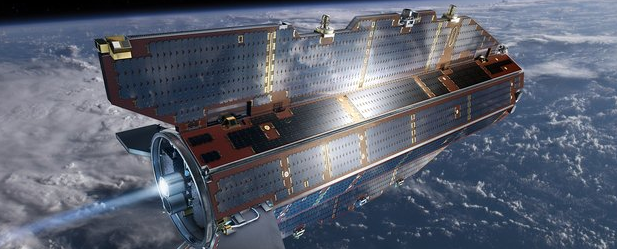ESA's GOCE satellite about to fall to the Earth

After nearly tripling its planned lifetime, the ESA's Gravity field and steady-state Ocean Circulation Explorer – GOCE – has completed its mission. The satellite will re-enter our atmosphere this weekend and break-up into pieces. It is expected that about 20% of its initial mass, or about 200 kg, will survive the fall and reach the ground.
No one knows exactly where its fragments will land but ESA is saying that the risk to the population on ground will be minute. Statistically speaking, it is 250 000 times more probable to win the jackpot in the German Lotto than to get hit by a GOCE fragment, they said.
GOCE's end of mission was declared on October 21 when its ion propulsion engine ran out of fuel mid October and it started to loose altitude. By October 24th GOCE's orbit has decayed by about 5.5 km and the satellite was at an altitude of about 218.5 km.
Re-entry of GOCE into Earth’s atmosphere is predicted to occur during the night between Sunday and Monday, 10/11 November.
Dr. Heiner Klinkrad, Head of ESA's Space Debris Office, explains: "When the spacecraft reaches altitudes below 100 km, then atmospheric density will drastically increase. Starting with a velocity of about 25 000 km/h, air drag with the concomitant aerodynamic pressure and heating will cause a break-up of the spacecraft at approximately 80 km altitude, causing a large number of fragments."
Mission managers will keep some of GOCE's instruments operating for as long as possible in order to collect scientific data and assess the performance of the spacecraft under the harsh conditions of its descent.
Most of the fragments will completely burn up and only a small fraction of the initial spacecraft mass – about 20% or 200 kg – is expected to reach ground. What is left of GOCE will be distributed across dozens of fragments and spread over a sizable re-entry ground swath.
"The spacecraft keeps performing excellently at these extreme conditions, exceeding our expectations," said Christoph Steiger, operations manager for GOCE, yesterday. "We are still getting good acceleration data from the Gradiometer, which may be of much value for atmospheric density studies … The two scientific GPS receivers — the so-called Satellite-to-Satellite Tracking Instruments (SSTI) — are also still fully operational."
If you want to track GOCE in orbit check this tracking map powered by N2YO.
About GOCE

Since March 2009, GOCE has been orbiting Earth at the lowest altitude of any research satellite.
Although the planned mission was completed in April 2011, the fuel consumption was much lower than anticipated because of the low solar activity, enabling ESA to extend GOCE’s life.
In August 2012, the control team began to lower the satellite’s orbit – from about 255 km to 224 km. Dubbed ‘GOCE’s second mission’, the lower orbit increased the accuracy and resolution of GOCE’s measurements, improving our view of smaller ocean features such as eddy currents.
“This innovative mission has been a challenge for the entire team involved: from building the first gradiometer for space to maintaining such a low orbit in constant free-fall, to lowering the orbit even further,” said Volker Liebig, ESA’s Director of Earth Observation Programmes.
“The outcome is fantastic. We have obtained the most accurate gravity data ever available to scientists. This alone proves that GOCE was worth the effort – and new scientific results are emerging constantly.”
With a sleek, aerodynamic design responsible for it being dubbed the ‘Ferrari of space’, GOCE has mapped variations in Earth’s gravity with extreme detail. Scientists further exploited these data to create the first global high-resolution map of the boundary between Earth’s crust and mantle – called the Moho – and to detect sound waves from the massive earthquake that hit Japan on 11 March 2011, among other results.
Featured image: ESA /AOES Medialab

Commenting rules and guidelines
We value the thoughts and opinions of our readers and welcome healthy discussions on our website. In order to maintain a respectful and positive community, we ask that all commenters follow these rules.